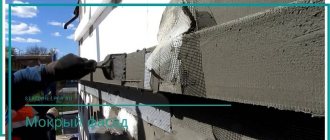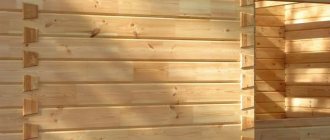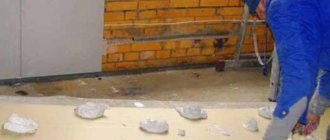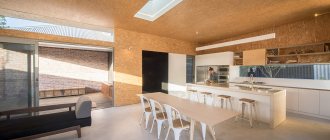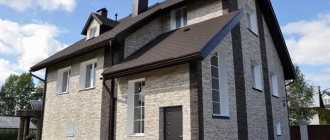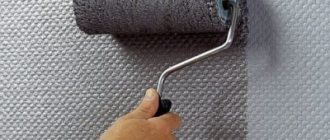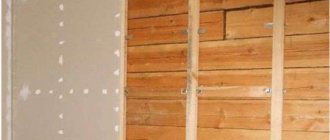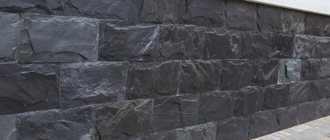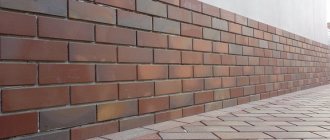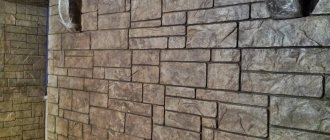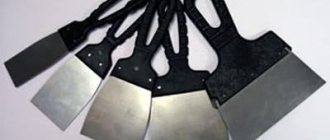Pros and cons of stone cladding of facades
Stone cladding of building facades is superior to any other materials in terms of strength and durability. This is the main argument regardless of the origin of the material: it is mined in a quarry or created by human hands. The impact of stone blocks on human health has been studied over centuries of use - it is one of the most environmentally friendly materials.
The combination of stone blocks and other finishing materials looks very nice Source uz.everaoh.com
Advantages of a facade made of natural stone
In addition to the spectacular and elegant appearance of the house, stone cladding has many practical advantages over other finishing materials:
- The material, formed over centuries, is extremely practical : it is able to withstand any natural disasters, an almost unlimited number of freezing and defrosting cycles, strong static and dynamic mechanical stress.
- The environmental safety of living in a house with stone cladding is unconditional, especially in comparison with modern polymer building cladding materials.
- The service life of a façade made of stone blocks is unlimited. The shortest of rocks, for example, limestone, can last for tens of generations; signs of destruction appear only after a millennium.
- In nature, it is impossible to find two identical stones, which means that the house will have its own individual face and unique appearance.
The decoration with “wild” stone is particularly diverse and beautiful Source stavba.hyperinzerce.cz
Flaws
A significant disadvantage of the material is its weight . These are additional transportation costs and processing difficulties.
An important negative aspect of installing cladding in a long-built house that is not designed for stone finishing can be the lack of a reliable foundation for the façade cladding. This also entails significant costs for strengthening or expanding the foundation .
Advantages of artificial stone
Artificial facade stone can be created on the basis of cement, gypsum binders, using various technologies for firing clay or imparting the desired properties to polymers. The main goal of such technologies is to create a material similar in appearance to stone, but at a significantly lower cost. There are many such materials on the market and the manufacturer gives them the necessary properties and qualities for a specific purpose:
- required weight and optimal dimensions for efficient operation and ease of installation;
- sufficient parameters of resistance to all types of atmospheric and mechanical influences;
- the stone can be “aged” or emphasized and highlight the color and texture properties of the simulated rock;
Several types of stone in facade decoration Source 2gis.ru
- to simplify installation, special shapes are created for corners, slopes, and complex architectural decorative elements;
- convenience and ease of processing during construction work.
Even a specialist cannot always visually distinguish artificial stone from natural stone.
Flaws
The main disadvantage of artificial material is its significantly shorter service life compared to natural material - it is difficult to compete with nature.
There is a risk of purchasing low-quality material that does not meet the specified quality and safety parameters.
Artificial stone for finishing a private house
Artificial facade stone is made using many components: cement, gypsum, clay. The composition also contains polymer substances, and various firing technologies are used. The material obtains properties similar to natural stone and is in no way inferior in strength and reliability. Before purchasing a stone for the facade of a house, you should definitely pay attention to its quality. For convenient installation and efficient operation, it must have the required weight. There must also be sufficient parameters for resistance to various factors. The products can be artificially aged, which will give the facade a special piquancy. It is very difficult to visually find differences in natural stone for a facade and artificial one. During construction and installation work, various technologies can be used, which are individually selected by craftsmen. Artificial material can be easily purchased at a hardware store or placed an individual order through the manufacturer. A significant disadvantage of artificial material is its significantly shorter service life compared to its natural counterpart. You should also take into account the likely risk of purchasing a low-quality product, so it is better to buy it with a specialist.
Natural natural facing material
Natural cladding stone is an excellent finishing material. But it cannot be used for cladding in its natural state: certain processes are required to transform the blocks into building material.
Decorating a house with natural stone Source housechief.ru
Primary processing, properties, pricing
By mechanical or manual processing, tiles are produced with all the qualities and properties inherent in the original stone block, but are much lighter in weight. The complexity of processing depends on the density of the rock, but new technologies make it possible to cut and transform any stone into an excellent building material.
The pricing of tiles consists of the costs of extraction, transportation, and processing. It is more rational to purchase stone from nearby deposits, because the costs of transporting heavy material make up a large part of its cost.
Stone tiles - no two elements are alike Source kamenhouse.ru
Sawn stone
Natural stone processed mechanically is usually called sawn. It has unique properties in terms of strength, durability, decorativeness, and its specificity is due to the presence of a wide variety of sawing options.
There are many types of sawn stone tiles; they can vary in type, color, processing shape, and size.
When laying, sawn stones can be combined with each other Source yandex.ru
See also: Catalog of companies that specialize in finishing and facade materials.
5 types of stone for facades
Professionals have adopted the following division by type:
- “Euro-2”: tiles with dimensions 60x30x2 cm;
- slabs: made from solid blocks;
- wild stone: irregularly shaped layers with processed corners;
- die: consists of pieces;
- Moscow fur coat: a die-like material characterized by ragged edges on the main side.
Wild stone: the most popular material for facade cladding
A material created by nature over thousands of years. Wild stone is distinguished by a variety of combinations of shapes and colors. Obtained by splitting large slabs, the facing material for the facade has different shapes, sizes, rough surfaces and torn edges. Its deposits are found everywhere, it is in demand and popular as a stone for the facade of a house, the variety of types and types can satisfy every taste.
Divided into the following types:
- Flagstone , or torn stone, plastushka - uneven, unedged material in the form of a flat slab with irregularities, is considered the main type of untreated wild stone. The size of the technological stone slab is 40x40 cm, thickness up to 3 cm, the texture is unique and cannot be perfectly imitated.
“Wild” flagstone Source oooarsenal.ru
- Fatwood is mainly used in masonry of walls, pillars, and columns due to its decorative edge. Stone blocks 6-15 cm thick are used to construct retaining walls.
“Wild” fat man Source vnovinky.ru
- Wild rubble stone has arbitrary sizes and shapes and is used in its raw form for constructing landscape objects.
Rubble stone Source recn.ru
What materials are best to combine finishing with?
When offering decorative solutions for decorating facades with stone, designers focus on the combination of additional finishing materials with the main one.
Most often, it is customary to combine the stone as follows::
- with decorative plaster. You can plaster the walls, and decorate the corners, ledges, and bases with stone, observing the contrast of colors;
- with another type of decorative stone, alternating the location;
- with facing brick;
- with tiles.
You can use a combination of thermal panels and stone, or combine stone with wooden boards or even lining.
NOTE!
The color of the material is of great importance: it can emphasize any elements, as well as hide flaws.
When using several types of materials, it should be remembered that a large stone visually reduces the area, and a light wall covered with plaster appears larger.
Stone façade installation technology
The basic rules for laying do not depend on the type of stone for the facade, its shape or species. The technological process can be divided into two stages: surface preparation and cladding.
Preparation
Preparation of the working surface for cladding is mandatory; it includes:
- cleaning the surface under the cladding from dust and dirt;
- degreasing and, if necessary, removal of old coating;
- repair of chips, cracks, potholes.
A galvanized metal mesh is attached to the cleaned surface for a tight connection with the facing layer.
Installation of stone panels on a grid Source stroyfora.ru
Stuffing mesh on rough, durable surfaces is not always necessary; notches on the facing area are sufficient. But its use is desirable for better adhesion of the cladding and the base in all variants and for all types of stone.
Options for fastening the mesh depend on the surface material, but, as a rule, the mesh is attached with dowels of sufficient length to securely fasten it.
Installation of stone: main points
technological operations of façade cladding can be identified :
- The laying of the material with a sawn surface is carried out on a cement-sand mortar, the joints are filled with special mastics or the same mortar with grouting or jointing.
- If the thickness of the stone block is no more than a centimeter and the area is no more than 0.4 m², additional fasteners are not needed.
- Small gaps are required between the stones in the masonry.
- The base is made of stone blocks of a darker color.
- The most careful control is necessary when laying out corners, facing slopes and cornices.
- The finished look of the work is given by additional measures to preserve the decorative and operational qualities of the facade. One of the primary measures is considered to be hydrofibization of the facade from the appearance of moss, mold, and vegetation.
Applying a hydrophobic solution to a stone facade Source shtukar.by
How to cladding with natural stone
Before starting facing work, a working solution is prepared, followed by the following stages of work :
- The zero or starting level is determined.
- The corners of the cladding are installed, that is, first the tiles are fixed to the corners of the wall.
- Tapping a level or connecting corners with thread for the bottom of the initial row.
- A layer of mortar is applied to the stone and to the surface of the wall.
- The stone is pressed and excess mixture is removed.
- The vertical level is constantly monitored.
- The cornices and window slopes are covered after the walls are finished. After covering one wall, the entire process is repeated on the adjacent surface with the starting mark transferred to it.
Cladding technology
Installation should begin from the top so that falling glue from the upper elements does not fall on the masonry.
Next, perform the work in order:
- The corner elements should be laid from top to bottom first;
- openings and window elements are laid out exactly along the edge (if the parts have the correct shapes), or as the shape suggests;
- the solution should be applied directly to the wall and the part to be glued;
- If necessary, the seams should be unstitched. To do this, you need to clean the seams, squeeze out the composition using a cone device and fill the seams.
The cladding should not be 600-700 mm below the ground to avoid peeling of the coating from contact with cold soil.
Cladding work should not be carried out in frosty or too hot weather. If the weather is dry, the wall should be moistened before installation.
Video description
For information on surface cladding with artificial stone, watch the following video:
Brief characteristics of the main types of stone
Each of these materials is good in its own way and has a lot of advantages, and it is important for the consumer to know them in order to choose the optimal option for finishing the facade of a house with stone.
- Granite . The material is of igneous origin, the strongest, but also the heaviest. The large specific gravity creates difficulties in processing, transportation, and installation, which affects the price - it has the highest cost.
Raw granite Source podsobka.com
- Marble . Beautiful, dense, easy to process, but difficult to use. Loss of appearance and staining may occur under certain unfavorable conditions.
Natural marble Source yandex.ru
- Limestone . Material of organic origin with a number of positive parameters: light weight; has thermal insulation properties; safe from an environmental point of view; has bactericidal properties; easy to process. In facades it requires treatment with water-repellent compounds. Affordable.
Raw limestone Source slide-share.ru
- Sandstone . Wear-resistant, cannot be polished, rough to the touch, a popular finishing material. Has colors: yellow, beige, dark brown. It has a relatively inexpensive price.
“Wild” sandstone for finishing Source bizator.ua
Advantages of a stone facade
Finishing the facade with natural stone can be called eternal; it will serve more than one generation. This option is chosen by aesthetes and pragmatic people who pay tribute to reliable material that is different:
- strength;
- durability;
- endurance;
- environmental safety;
- resistance to fire, temperature changes and precipitation;
- variety of natural color palette.
In addition, the housing will be guaranteed excellent sound and heat insulation qualities and a prestigious image. No special equipment or highly complex instruments are involved.
The samples are attached in fragments to a specialized adhesive base that can withstand a large mass. The cost of finishing a façade with stone is directly dependent on the chosen material, the configuration features of the structure, and the type of fixing mortar.
Specialist services
Firms specializing in the processing of natural stone can offer many unexpected (from the point of view of a non-specialist) services and additional processing and finishing operations:
- cutting a stone blank with straight and curved cuts;
- production of original and exclusive products of complex shapes, panels, mosaics;
- polishing of ends with various types of chamfer;
- aging the surface using acids and diamond brushes;
- cutting holes and cutting flutes with a milling cutter;
- repolishing and polishing of the second side, rounding of corners, reinforcement.
Types of stone for facade
For the external decoration of buildings they often use:
- Granite, a symbol of monumentality and solidity.
- Limestone, easy to process, with bactericidal properties.
- Rough sandstone that does not absorb water.
- Quartzite, which can protect even from radiation.
- Slate with a layered structure and unusual play of colors.
- Rubble stone with an irregular shape, complicating installation.
Other types are also known, for example, marble, which quickly loses its marketability, expensive and beautiful, but short-lived dolomite, labradorite, they are less popular. A heavy layer will provide the façade with decent weight, so precise calculations will be required to find out the permissible weight limit.
The downside is not only the mass, but also the complexity of processing. It is advisable to entrust a labor-intensive and responsible task to specialists so as not to throw money away.
Prices for facade cladding in Moscow
Pricing for façade cladding by construction organizations should be based on ENiR standards (Unified Norms and Prices), multiplied by the coefficient in effect at the time of work. In reality, prices for construction work in different organizations can vary significantly. The price for work may be influenced by the following factors:
- volume, timing and location of work;
- the condition of the walls for cladding and the degree of complexity of the preparatory work;
- type, type and even price of finishing material.
If we talk about the current average price for performing facade work, then we can settle on the following approximate amounts for 1 sq.m of cladding:
- working with natural stone to finish facades and plinths will cost the customer 2,000 rubles per m²;
- the same work, but with artificial stone blocks - 1400 rubles/m².
Don't forget about additional work. For example, hydrophobization of a façade stone surface will cost approximately 75 rubles per m².
Preparing the surface for installation
A properly prepared wall for stone installation will ensure reliable adhesion of the adhesive composition and good adhesion of the material.
The preparatory stage is as follows:
- it is necessary to level the walls;
- plaster protruding elements, seal cracks (applies to concrete and brick walls);
- remove nails, secure boards, replace moldy elements, waterproof and lay reinforced mesh (for wooden walls).
IMPORTANT!
For wooden surfaces, it is recommended to install a continuous sheathing on the frame, on which the stone elements will then be laid.
The walls are plastered, sanded, primed, and then an adhesive is applied to which the facing elements are glued..
Stone panels for facades
Finishing the facade with stone panels suits absolutely any building. The polymer material, resistant to frost and heat, does not load the foundation and does not require excessive maintenance; another important plus is that the mount is accessible even to a person without experience. The design of the devices is as similar as possible to natural wood in texture and color. Even from a distance of two steps the difference is almost invisible.
It is especially pleasing that the installation of façade models occurs in any weather without preparatory manipulations. After arranging the sheathing, the coupling with self-tapping screws begins. The main thing is to follow the recommendations and leave the necessary gaps so that the walls do not “float”.
A little about installation
Installation of both natural and artificial stone is approximately the same. In theory, everything is simple and easy to remember, but the problem is that you first need to “train” your hand, i.e. practice.
- Laying is done only on a solid base, and if there is old plaster left, it will be tedious to knock it down. To begin with, you should coat the base several times with a primer with strengthening and deep penetration.
- Next, using dowels, you need to attach a galvanized metal mesh to the base.
- It is better to secure the starting profile from below; usually a corner is used for this. But if for some reason you don’t have one, just nail a flat piece of wood. After the glue has set, the profile will need to be removed.
- Afterwards, construction adhesive is applied to the reinforced wall using a trowel and the stone is laid. Glue is applied not only to the wall, but also to the stone.
- At first, the glue will set well, so we first lay the stone on the ground and then transfer it to the wall.
Please note that previously, finishing a house with stone was done using sand-cement mortar, but now these are relics of the past, since there are many types of construction glue. Although the solution will cost you less, only a professional installer can work with it.
